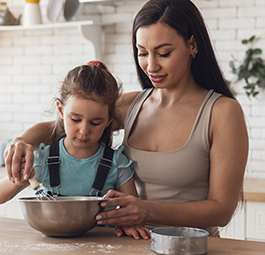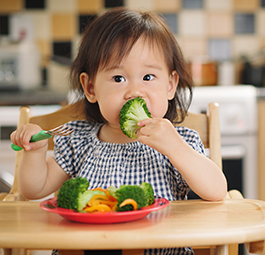Recipes & Diet

Replacing Egg
The following is a general guide to using ingredient substitutions for egg allergy. Please verify the ingredients and safety of any products named to make sure that it is safe for your child.
If you need additional assistance in finding product suggestions or where to find ingredients, post a message in the KFA Food and Cooking Support Forum to get suggestions from other parents who are also managing the same food allergies.
Basic Ingredient Substitutions for Food Allergies
Many common allergens are also common ingredients in your favorite recipes. There are some ingredients which can be easily substituted. There are others that may be more challenging. Whether or not a “safe” version of a recipe can be successfully made often depends on two important factors. First: what is the role of the ingredient in the recipe? Second: how many of the recipe’s ingredients require substitutions? If the recipe only has 5 ingredients and you need to swap out 4 of them, the end result might bear little resemblance to the original dish. The bottom line: sometimes you can create a “safe” version of a recipe, and sometimes you are better off finding a different recipe altogether.
Egg Substitutes for Baked Goods
In a typical recipe for baked goods, eggs generally play one of two roles: binder (to hold the recipe together) or leavening agent (to help it rise). Sometimes eggs play both roles at once. Determining the purpose of the eggs in your recipe will help you determine what options for replacements you might have.
As a rule of thumb, if a recipe for baked goods calls for three or more eggs per batch (with a typical “batch” consisting of 36 cookies, one pan of brownies, one loaf of bread, or one cake), egg substitutes generally do not work well. The consistency of the finished product comes out poorly. Pound cakes, sponge cakes, angel food cakes, and other popular desserts with relatively high egg content do not turn out well in egg-free cooking. In these situations, it is usually best to make something else.
There are commercial egg replacement products on the market. Be sure that you are considering an egg replacement, not an egg substitute. Egg substitutes are generally marketed in the dairy portion of the grocery store, and are designed for cholesterol-conscious people, rather than for people with egg allergy. They contain egg, and are unsafe for those with egg allergies. Commercial egg replacement products (such as Ener-G brand Egg Replacer®, a popular powdered product that is available in natural foods stores across the U.S.) generally will work for either binding or leavening purposes. As with any other product, be sure to read the ingredient statement to ensure that the product is indeed safe for your child.
Eggs As a Binder
For recipes which use eggs primarily as a binder (such as drop cookies), use one of the possible substitutions for one egg:
- 1/2 of a medium banana, mashed
- 1/4 cup of applesauce (or other pureed fruit)
- 3-1/2 tablespoons gelatin blend (mix 1 cup boiling water and 2 teaspoons unflavored gelatin, and then use 3-1/2 tablespoons of that mixture per egg)
- 1 tablespoon ground flax seed mixed with 3 tablespoons warm water; let stand 1 minute before using
- Commercial egg replacement products (see above)
Keep in mind that the addition of pureed fruit may impact both the taste and the density of the finished product.
Xanthan Gum
Xanthan gum can be added to egg-free cakes and cookies, as well as milk-free ice cream, to bind and add texture. Use about one teaspoon per recipe. Xanthan gum is a white powder derived from the exoskeleton of a bacterium. It is cultivated on corn sugar.
Eggs As a Leavening Agent
For recipes which use eggs primarily as a leavening agent you can try a commercial egg replacement product (see above) or the following mixture:
1-1/2 tablespoons vegetable oil mixed with 1-1/2 tablespoons water and 1 teaspoon baking powder per egg.
Note: this mixture calls for baking powder, not baking soda. The two products are not interchangeable.
Egg White Glaze
Occasionally recipes will use egg whites as a glaze, with the beaten egg whites brushed onto the top of the item before it is cooked. One good option here is to use melted margarine instead of the beaten egg whites.
Updated December 2022.














